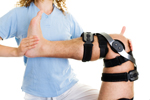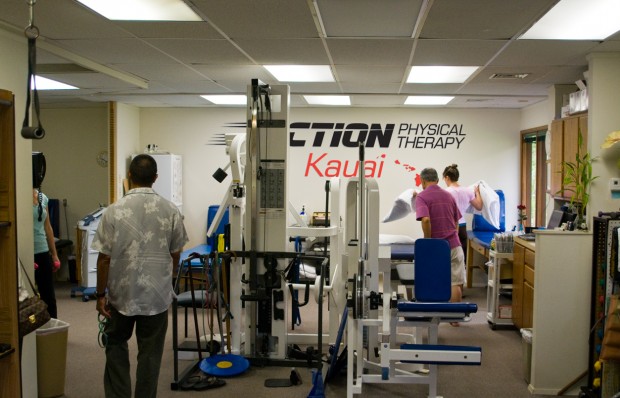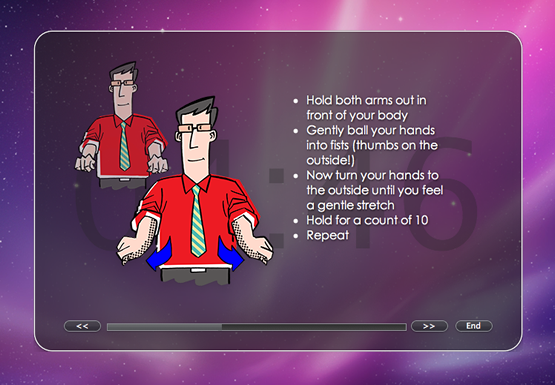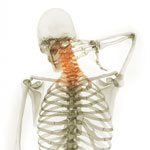Kauai Physical Therapy Blog
Home of Action Physical Therapy: Kauai's Premier Physical Therapy and Personal Fitness Clinic
Testimonial from a Health Care Professional
Dr. Richard Blair
Elbow Hyperextension Taping
Understanding Your Spine
Understanding your spine is the first step to proper spinal health
 The 24 separate bones, or vertebrae, all stacked on top of each other make up the structure known as your spine. Those vertebrae are the main framework that protects the most important spinal cord. There are five sections of the spine:
The 24 separate bones, or vertebrae, all stacked on top of each other make up the structure known as your spine. Those vertebrae are the main framework that protects the most important spinal cord. There are five sections of the spine:
• cervical (top 7 vertebrae)
• thoracic (12 vertebrae)
• lumbar (5 vertebrae)
• sacrum
• coccyx
To perform (hopefully) all of those complex movements that the spine is capable of, between each vertebrae is a disc that essentially works as a cushion to absorb shock of the impact your spine endures during both normal activity such as walking, or high stress activity like surfing. And holding the vertebrae and discs together are the ligaments. And completing the spinal structure are the tendons that attach the muscles to the spine itself.
The Sections of the Spine
The cervical spine, the neck, consists of the top seven vertebrae. The cervical spine is the most flexible, complex and mobile region of the spine and enables you to move your head from side to side and up and down. In the cervical spine are two very unique vertebra, the atlas and the axis. It is these vertebrae that are specially adapted to enable such complicated rotation.
The thoracic spine are the 12 vertebrae below the cervical spine section of the spine. Your ribs connect to the vertebrae in the thoracic spine.
The lumbar spine or ‘lower back’ consists of five vertebrae. Sometimes however, there is a sixth vertebrae in the lumbar section of the spine.The lumbar is located below the thoracic section of the spine. The lower back bears a great deal of the weight of the body and for that reason is particularly vulnerable to back pain.
ACL Knee Injury Rehabilitation
Rehab a Injured Anterior Cruciate Ligament
 A torn ACL is an injury or tear to the anterior cruciate ligament (ACL). The ACL is one of the four main stabilising ligaments of the knee. The ACL attaches to the knee end of the Femur (thigh bone), at the back of the joint and passes down through the knee joint to the front of the flat upper surface of the Tibia (shin bone).
A torn ACL is an injury or tear to the anterior cruciate ligament (ACL). The ACL is one of the four main stabilising ligaments of the knee. The ACL attaches to the knee end of the Femur (thigh bone), at the back of the joint and passes down through the knee joint to the front of the flat upper surface of the Tibia (shin bone).
What should you do if you have injured your ACL?
- Immediately stop play or competition
- Apply RICE (Rest, Ice, Compression, Elevation) to the knee immediately
- Seek medical attention as soon as possible.
Your physician will diagnose any additional injuries, and you may be sent for an MRI scan or X-ray. You may be refered for ACL Surgery if required. Your physician will provide a pre-surgery rehabilitation program to strengthen the knee and reduce the swelling in preparation for surgery. This will help produce the best results following surgery.
The steps to proper rehabilitation will vary from case to case. The following is provided only as a reference and not a substitute for a physician’s diagnosis.
Immediately following surgery
- For approximately 2 weeks the initial protocol will be largely rest and use of crutches
- Ice and compression as before to reduce post-operative swelling
- Mobility exercises to regain full range of motion
- Hamstring stretching
- Strengthening exercises such as: quadriceps contractions, hamstring contractions and calf raises.
Two weeks following surgery
- Increase walking and aim for normal gait
- Continue mobility and strengthening exercises
- Progress hamstring curl exercises to using tubing or a resistance machine
- Introduce half squats and shallow lunges
- Start hip flexor strengthening and adduction and abduction exercises
- Balance and proprioception drills
- Continue icing after activity if swelling persists
Six weeks following surgery
- Progress to full lunges and squats, add weight for extra resistance
- Increase resistance/reps for strengthening exercises
- Single leg press or half squats
- Start straight line jogging
Twelve weeks following surgery
- Use a mix of training activities such as running, cycling, swimming to build aerobic fitness
- Gradually increase speed and duration of running
- Introduce running drills incorporating sideways and backwards running, change of direction and cutting maneuvers
- Jump and land drills
- Sports specific drills (e.g. football/hockey dribbling/passing)
- Continue with flexibility and strengthening exercises as before
often the patient will be given an exercise regime to continue even after being released from physical therapy and given the green light to return to normal activity.
For more information call the rehabilitation experts at Action Physical Therapy at 808-246-0144.
For more info, please visit the Sports Injury Clinic online.
Direct Access in Hawaii—What that Means for You
 Direct Access to Physical Therapist is now available.
Direct Access to Physical Therapist is now available.
According to Ann Frost, PT, president of the Hawaii Chapter of APTA, “Hawaii’s people can now enjoy the ability to receive physical therapy in a more cost- and time-effective manner.” Specifically, patients can now receive treatment from a licensed physical therapist without a physician’s referral.
So what does that mean for you? Instead of visiting your chiropractor for weekly maintenance, or your acupuncturist to ease your pain briefly, you can now go directly to a physical therapist to fix what ails you.
A licensed physical therapist is a true health care professional with at least a four-year degree who has passed a demanding physical therapy exam. A physical therapist specializes in the evaluation and treatment of various diagnoses that limit physical functioning. Our physical therapist work with you to restore health and foster optimal physical function. They don’t address the symptom, they define the root issue and provide remedies and long term solutions.
At Action Physical Therapy Kauai, this means we begin each client relationship with a thorough examination to identify potential and existing problems. Before we create your personal program, we will discuss your history in detail and use established tests and measures to forecast how successful we can be in addressing your issue.
To read more go to American Physical Therapy Association’s article on direct access on the APTA web site.
Carpal Tunnel Syndrome Basics
Now that most of us spend at least a small part of the day on a computer if not the entire work day, understanding Carpal Tunnel Syndrome becomes more important. With simple prevention techniques along with good nutrition and regular exercise you can protect yourself from the dangers of Carpal Tunnel.
Practice good ergonomics.
It is your right and personal responsibility to set up your work station with proper ergonomics. There are several simple steps to make sure you are not putting undue stress on your eyes, neck, back and wrists.
Position yourself properly at your computer. Your screen should be 18″ to 24″ away from you and the top of your document should be at eye level.
Set up your keyboard so that it is flat or slightly elevated. Do not have your keyboard slanted downward.
Keep your wrists straight and elbows in a 90 degree angle while typing.
Rest your wrists when you are not typing.
Take frequent short breaks rather than one long break.
Stretch your wrists before work, during breaks, and after work.

A personal assistant pops up on screen to stop over-use, teach good ergonomics, and keep track of scheduled breaks.
For advanced assistance, you can use ergonomic software such as MacBreakz for Apple, a sophisticated personal ergonomic assistant designed to promote healthy and productive computer use.
The Perfect Holiday Gift
3 Great Core Exercises
At the basis of all good fitness, all strength training, all injury prevention, and all sports performance enhancement is core strengthening. At Action PT we strongly encourage the strengthening of your core as the single most effective way to improve your daily recreational and athletic performance.
Here are 3 great exercises that maximize the core strength and get you going down the road to peak performance.
1. Twisting Crunch
 Everyone knows what a crunch is. Heck, there is even a chain of fitness clubs named after this clichéd exercise. But the twisting crunch has replaced the normal crunch as one of the best core exercises. The twisting version targets every abdominal muscle at the same time.
Everyone knows what a crunch is. Heck, there is even a chain of fitness clubs named after this clichéd exercise. But the twisting crunch has replaced the normal crunch as one of the best core exercises. The twisting version targets every abdominal muscle at the same time.
1:: Start with your typical crunch position, fingers behind ears
2:: Lift up you upper body to a 45 degree angle, and then twist from left, to right, to left again.
3:: Do this quickly for the best results.
2. Plank
![]() Sit ups are so last decade. So what’s the the number one core exercises to build up your upper and lower body muscles? The Plank. When done correctly, this simple static manouver will bring on that 6-pack in a hurry.
Sit ups are so last decade. So what’s the the number one core exercises to build up your upper and lower body muscles? The Plank. When done correctly, this simple static manouver will bring on that 6-pack in a hurry.
1:: Lie down flat on your stomach.
2:: Slowly push your body up with your forearms while maintaining your elbows at a 90 degree angle
3:: Keep your body straight for a minute for each rep.
Not gnarly enough? Lift one foot off the ground or add in a stability ball.
3. V Sit Hold
 The V sit is very intense. It is a mental game that is easily lost. But this one is about maintaining proper form for as long as posible. It really hones in on your abs and helps you build up your core stability.
The V sit is very intense. It is a mental game that is easily lost. But this one is about maintaining proper form for as long as posible. It really hones in on your abs and helps you build up your core stability.
1:: Lie completely flat on your back
2:: Lift your arms and legs off the ground to create a “V” shape.
3:: Hold. Maintain this position for as long as you are physically able to.
We hope we have encouraged you to try these 3 basic core exercises. We know you will benefit from them. If you need more help, or want to go further (or recover) call us to discuss your health and wellness needs. 808-246-0144
The Best Exercises and Technique Tips for Stand-Up Paddling
The fast-growing sport of stand-up paddle boarding is a phenomenal core workout that’s also a fun way to spend time on the water. The hip and shoulder rotation required to plant the paddle vertically and uncoil the hips, and thus move the board forward, is no different than the movement used to swing a golf club, tennis racket, or baseball bat. The difference, of course, is that the paddler is operating on an unstable surface—the water—in effect making the board a giant BOSU ball.





